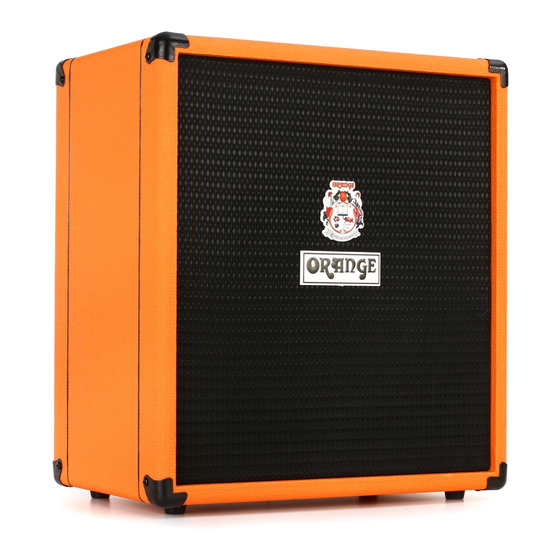
Table of Contents
Advertisement
Advertisement
Table of Contents

Summary of Contents for ORANGE Crush Bass 50
- Page 1 Manual V1.0 Crush Bass 50 Manual Introduction...
-
Page 2: Important Safety Information
Thank You for Choosing Orange Ever since the founding of the company in 1968, Orange has been a pioneering force in the guitar amplification industry. Today, with a team of the world’s finest amplifier engineers, Orange continues to push back the boundaries of conventional amplifier design. - Page 3 The voltage selector switch and mains fuse are set at the factory for the country or region in which this Orange product is intended to be sold. To prevent serious damage to the product, ensure that the rated AC mains voltage indicated on the product's rear panel agrees with the mains voltage from your AC mains outlet before connecting the mains cord/plug.
-
Page 4: Panel Features
Connect the equipment into an outlet on a circuit different from that to which the receiver is connected. Consult the dealer or an experienced radio/TV technician for help. Changes or modifications not expressly approved by Orange Music Electronic Co. could void the user's authority to operate the equipment. Panel Features... - Page 5 Volume Controls the output volume level.
- Page 6 Treble Adjusts the upper frequencies with up to 20dB of boost (max. setting) or cut (min. setting). Middle Controls the effect of the FREQ dial with up to 15dB of boost (max. setting) or cut (min. setting).
- Page 7 Bass Adjusts the low-end frequencies with up to 15dB of boost (max. setting) or cut (min. setting). Gain Controls the level of gain applied to the upper frequencies. Increasing the GAIN adds extra harmonics and, at higher settings, heavy distortion. The GAIN control works together with the BLEND control.
- Page 8 Power Switches the mains power supply to the amplifier ON/OFF. Phones For use with most stereo headphones with a 6.35mm connection. The PHONES output also features Cabsim for a more authentic sound, and can be used to send a signal to a recording console/mixer. The internal speaker is disconnected when the PHONES output is in use.
- Page 9 Aux In For use with MP3 players, laptops etc. via a 3.5mm audio cable. The audio signal is internally summed to mono. FX Loop Use the FX LOOP to connect external effects processors/pedals inbetween the amp’s preamp and output stages. Connect the SEND to the input of external effects.
- Page 10 Blend Controls the amount of gain/upper harmonics blended with the clean signal. The character of the BLEND control is defined by where the GAIN control is set. Higher BLEND settings will also add extra volume. With the GAIN set to minimum, the BLEND control will have the least effect on the overall sound.
- Page 11 Freq Selects the centre frequency of the MIDDLE control, sweeping from 300Hz (min.) to 2.7kHz (max.). Note: When the MIDDLE control is in the centre (12 o’clock position), moving the FREQ control will have no audible effect.
- Page 12 Input Use a quality shielded instrument cable to connect your instrument to the INPUT jack socket. The PAD switch selects the correct input level for basses with active or passive pickups. PAD engaged = -6dB. Tuner Depress the ON/OFF button to engage the integrated chromatic Tuner. Set the Volume to zero for silent tuning if required.
- Page 13 FX Loop Use the FX LOOP to connect external effects processors/pedals inbetween the amp’s preamp and output stages. Connect the SEND to the input of external effects. Connect the output of the external effects to the RETURN socket.
- Page 14 Footswitch Connect a latching footswitch (e.g. Orange FS-1) to remotely engage/defeat the BLEND/GAIN controls. 1. AC Mains Inlet Refer to ‘Before Using Your Amplifier‘. Connect the supplied IEC cable to the AC Mains Inlet. Ensure the Power switch is set to OFF before connecting the IEC cable.














Need help?
Do you have a question about the Crush Bass 50 and is the answer not in the manual?
Questions and answers